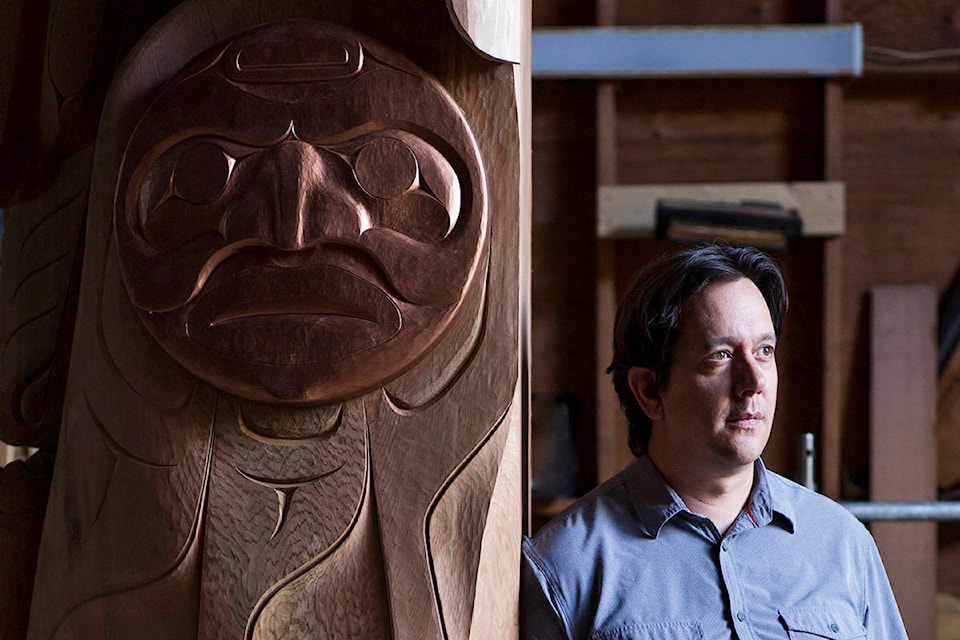- Story by Hans Tammemagi Photography by Lia Crowe
In 2008, Carey Newman, an artist of the Kwakwaka’wakw, Coast Salish and settler heritage, took an old-growth log on an epic journey. Aided by a small team that included his father, Victor, also a carver, he visited about 55 communities in all corners of British Columbia. At each stop, members of the public helped carve the Spirit Pole.
For a 33-year-old, it was an enormous responsibility — an ambitious project. Carey estimates that over 11,000 people contributed to transforming the pole into a towering work of art, which was raised at the opening ceremonies of the North American Indigenous Games.
A year later, Carey embarked on another megaproject when he was selected to create an art installation for the 2010 Olympic Games. The resulting piece, entitled Dancing Wind, consists of four large panels, made from stainless steel, cedar and glass, representing wind directions, animals and colours related to the medicine wheel.
And in the decade since then, the talented Carey, who grew up in Sooke, has gone from one success to another. His much-sought-after work has been acquired by corporations, government agencies and museums around the world. He is living up to his Native name, Ha-yalth-kingeme, which means Face of a Chief.
Recently, I visited him at his spacious carving shed on the Tsawout Reserve in the Saanich Peninsula, where three large crates containing his totems were being loaded onto a truck for shipment to Germany.
A tall, clean-shaven, good-looking man, Carey has a ready smile and a subtle humour born of his Indigenous roots. His art training occurred via the First Nations method of mentoring and apprenticeship, rather than through formal courses. This marked an obvious path as he comes from a family of carvers, including his father (Victor); his great-grandfather, Charlie James; and his great-aunt, Ellen Neel.
Carey is also a musician; he studied piano at the University of Victoria and voice at the Victoria Conservatory of Music. He had a brief singing career before deciding to pursue visual art exclusively.
Showing me a cedar log, he says, “I’m careful to adhere to traditional rules and values. Finding ways to innovate without disregarding history is important to me.”
He loves working with cedar, he added, because it is a central element of Indigenous culture.
“I’m deeply connected to the wood I’m working with.”
Through his work, he strives to highlight either Indigenous, social, or environmental issues, and his media extends far beyond wood to include stone, gold/silver, gems, glass and painting. His works were available at Blue Raven Gallery in Sooke from the mid-1990s until it closed 2018. The closure occurred not due to lack of sales, but lack of time and the fact that his parents were no longer able to run it.
Carey’s most significant work is the 12-metre-long , which has become a national monument. Starting in 2012, he visited residential schools, churches, government buildings and cultural structures in 77 communities across Canada to collect 887 fragments of the residential-school era.
“My dad is a survivor of the residential schools, which operated from 1870 to 1996 with 41,000 deaths. So I wanted to tell the story,” he says.
It took more than a year to collect the pieces, which included items such as a door, a piece of strap, hair cut from a female survivor, a skate and much more. Carey spent six months assembling the fragments into a row of panels, and ultimately a major art installation.
“The blanket is a universal symbol of protection,” he says. “For many of us, they help identify who we are and where we’re from — we wear them in ceremony and give them as gifts.”
The Witness Blanket is a moving and powerfully evocative way of remembering the residential school era. And after touring Canada extensively over the past few years, the Witness Blanket is undergoing conservation at the Canadian Museum for Human Rights in Winnipeg. A replica is being created, which will begin touring in May 2019.
Carey was awarded the Meritorious Service Medal in 2017 and a year later, he was named to the Order of British Columbia in part, no doubt, to the Witness Blanket.
“It was a great ceremony,” he says, “but I felt conflicted because a lot of my work is critical of government.”
Carey was also recently appointed as the 6th at the University of Victoria, a three-year position.
“This is breaking new ground for me,” Carey says. “I’m looking forward to having the opportunity to convert the experience of mentorship into a more formal educational setting.”
He is also working to establish a Centre of Excellence to study art and reconciliation as a legacy of the Witness Blanket.
With his ability to work with many media, and to create major, thought-provoking pieces, Carey Newman is arguably one of Canada’s most influential Indigenous artists. P



